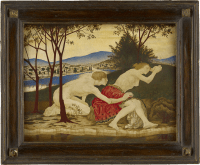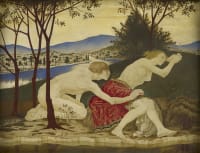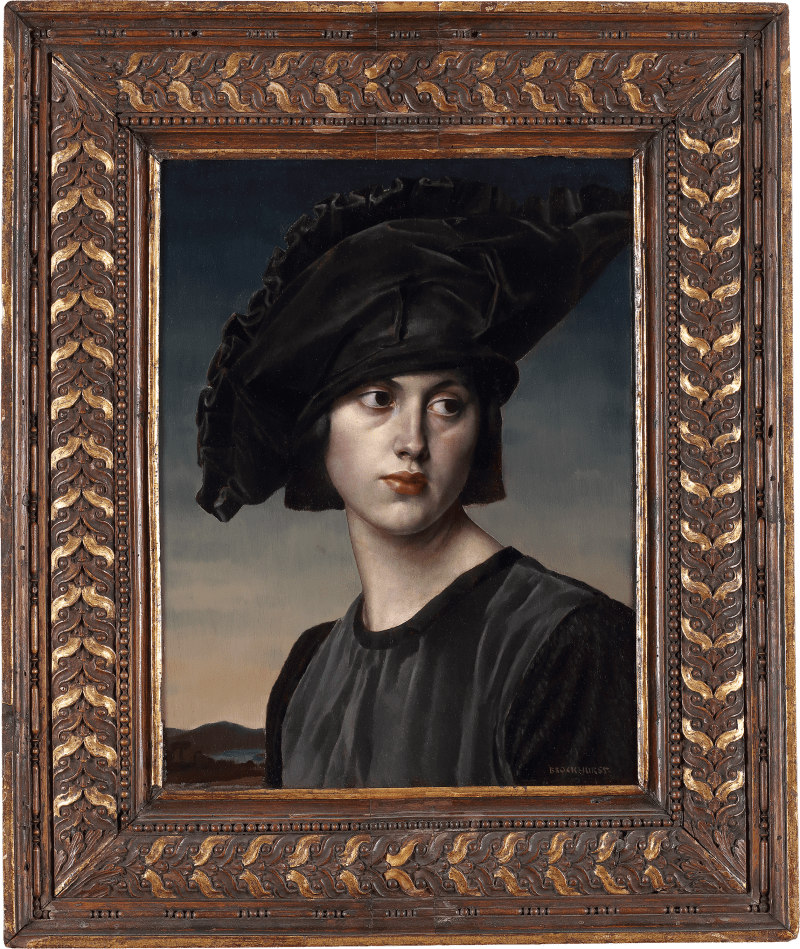

Gerald Leslie Brockhurst
(1890-1978) Daphnis and ChloeProvenance
Charles A. Jackson, Manchester, 1923.
Set on the Greek island of Lesbos, which is thought to have been the author’s home, Daphnis and Chloe is a story about the innocence and precariousness of young love. Longus writes that both Daphnis and Chloe were exposed at birth, a form of child...
This rhythmical subject taken from the literary work Daphnis and Chloe by the Greek novelist Longus (c.2nd century AD), was painted by the celebrated twentieth-century artist Gerald Brockhurst.
Set on the Greek island of Lesbos, which is thought to have been the author’s home, Daphnis and Chloe is a story about the innocence and precariousness of young love. Longus writes that both Daphnis and Chloe were exposed at birth, a form of child abandonment common in Ancient Greek society.[1] A goatherd called Lamon rescues Daphnis and raises him as a son and a shepherd, Dryas, finds Chloe and raises her as a daughter; both children grow up together tending livestock near the town Mytilene. Eros, god of love, intervenes causing the pair to fall in love, however, their physical relationship and sexual desires are hindered by the advice of several elders in the city. Daphnis and Chloe part ways, Chloe is courted by several suitors and is almost abducted,...
This rhythmical subject taken from the literary work Daphnis and Chloe by the Greek novelist Longus (c.2nd century AD), was painted by the celebrated twentieth-century artist Gerald Brockhurst.
Set on the Greek island of Lesbos, which is thought to have been the author’s home, Daphnis and Chloe is a story about the innocence and precariousness of young love. Longus writes that both Daphnis and Chloe were exposed at birth, a form of child abandonment common in Ancient Greek society.[1] A goatherd called Lamon rescues Daphnis and raises him as a son and a shepherd, Dryas, finds Chloe and raises her as a daughter; both children grow up together tending livestock near the town Mytilene. Eros, god of love, intervenes causing the pair to fall in love, however, their physical relationship and sexual desires are hindered by the advice of several elders in the city. Daphnis and Chloe part ways, Chloe is courted by several suitors and is almost abducted, Daphnis falls into a pit, is captured by pirates and nearly raped but by the end of the myth both children are reunited with their birth parents and they later marry.
This story has often been compared to a modern novel in its rhetorical and pastoral style and has been an inspiration for musicians, writers and artists throughout history. Brockhurst himself may have been inspired to create this piece after seeing Daphnis et Chloé, a ballet by Maurice Ravel, which premiered in 1912 at the Théâtre du Châtelet in Paris; Brockhurst was travelling France and Italy after winning a scholarship from the Royal Academy schools in 1913 and may have seen one of Ravel’s touring performances.[2] The theatrical positioning of Brockhurst’s figures and the Italianate landscape in this work, with a river running across the background, are reminiscent of Léon Bakst’s set design for Ravel’s ballet.[3] This painting would have been produced after 1914 as there exists a datable preliminary sketch of this composition which was exhibited in 1987 at the National Portrait Gallery, London.
Gerald Leslie Brockhurst was one of the most successful and fashionable British portrait painters of the early twentieth century. He was born in Birmingham, the son of a coal merchant and in 1901, at the age of 12, Brockhurst entered the Birmingham School of Art before enrolling in the Royal Academy Schools in 1907. A travelling scholarship enabled him to study Old Masters in France and Italy including the work of Leonardo da Vinci and Piero della Francesco whose stylistic and compositional ideas had a lasting effect on the artist’s career.
In 1914 Brockhurst married Anais, a Frenchwoman whom he presumably met whilst exploring the region, and the following year they moved to Ireland where they remained until 1919. He used his wife as a model for many of his early works including Portrait of Anais, the artist’s first wife, 1915-1920, with Philip Mould Gallery. Whilst in Ireland the couple befriended established painters such as Augustus John, whose influence can be seen in the rugged handling of paint in ‘Ireland, 1916’ [Hunterian Art Gallery, University of Glasgow]. On Brockhurst’s return to England in 1919, he held his first major exhibition at the Chenil Gallery in London, in which his work was described as giving ‘an edge to forms which vision does not experience’[4]. This ‘edge’ can be seen in Brockhurst’s most accomplished works.
During the 1920s Brockhurst began to champion the field of etching, paving the way for his later portraits which would betray an intelligence for enhanced chiaroscuro, which only a master etcher could attain. In particular his work Adolescence [The Fine Arts Museum, San Francisco], an etching of a nude woman sitting in front of a mirror, is considered one of the greatest examples of printmaking of the twentieth century – although its subject was rather controversial at the time. By 1930 Brockhurst had returned to painting and his career was flourishing with notable commissions from the notorious British socialite Margaret Campbell, Duchess of Argyll (1912-1993) [Tate Britain] and Wallis Simpson, Duchess of Windsor (1896-1986) [National Portrait Gallery].
In 1937 he was elected an Academician of the Royal Academy. This was the same year that his marriage to Anais started to break down, following the scandalous publication of his relationship with Kathleen Woodward, [Dorinda with Philip Mould Gallery].[5] As his marriage ended and demand for his work overseas increased, Brockhurst decided to move to America in 1939 and one year later Anais filed for a divorce. It was in America that Brockhurst achieved greater fame and had a number of notable patrons such as the Mellon family and J.Paul Getty; he would remain in America for the rest of his career. Gerald Leslie Brockhurst died in his home with Dorette on 4th May 1978 in Franklin Lakes, New Jersey.
[1] An unwanted child, often a child of the wrong sex, deformed at birth or born illegitimately would be taken by the father and abandoned outside. Exposed to the elements these children would die of ‘natural’ causes, often dehydration or starvation. This was not considered murder as it was believed that the child could be rescued by a passer-by or by the gods.
[2] M. Ravel, Maurice Ravel Daphnis and Chloe Suites I and II in Full Score, (New York, 2006).
[3] Stage set design for Act I of 'Daphnis and Chloe' by Maurice Ravel (1875-1937) by Leon Bakst, 1912, Musee des Arts Decoratifs, Paris.
[4] Vogue, 15 April 1919.
[5] The British Portrait 1660-1960, the Antique Collectors Club, England 1991. p409.











